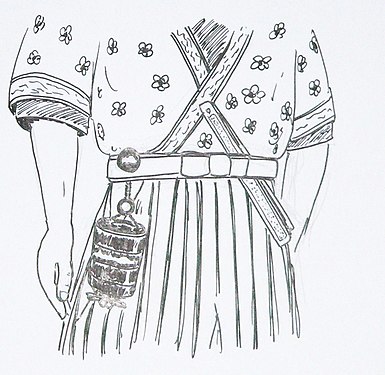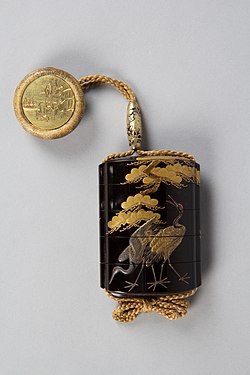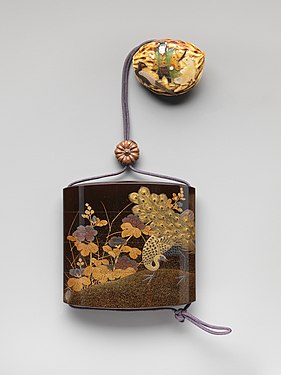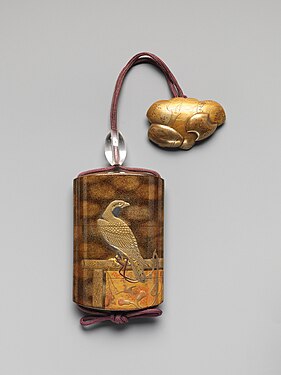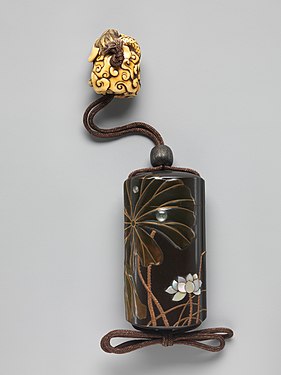Inro
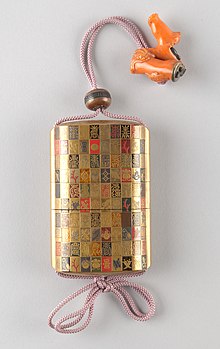
Aninro(Ấn lung,Inrō,lit."stamp case" )is a traditional Japanese case for holding small objects, suspended from theobi(sash) worn around the waist when wearing akimono.They are often highly decorated with various materials such aslacquerand various techniques such asmaki-e,and are more decorative than otherJapanese lacquerware.[1][2]
Because traditional Japanese dress lacked pockets, objects were often carried by hanging them from theobiin containers known assagemono(a hanging object attached to a sash). Mostsagemonowere created for specialized contents, such as tobacco, pipes, writing brush and ink, but the type known asinrois suitable for carrying small things, and was created in theSengoku period(1467–1615) as a portableidentity sealand medicine container for travel.[1][2]
In the middle of theEdo period(1603–1868),inrobecame popular as men's accessories, and wealthy merchants of thechōninandsamuraiclasses collectedinrooften beautifully decorated with lacquer. As the technique developed from the late Edo period to theMeiji period(1868–1912) and the artistic value ofinroincreased,inrowere no longer used as an accessory and came to be regarded as an art object for collection.[1][2]
The terminrois a combination of thekanjiforin(Ấn),which means asealor stamp, and the kanji forrō(Lung),which means a basket.
Description[edit]
Consisting of a stack of tiny, nested boxes,inrowere most commonly used to carry medicine. The stack of boxes is held together by a cord that is laced through cord runners down one side, under the bottom, and up the opposite side. The ends of the cord are secured to anetsuke,a kind of toggle that is passed between the sash and pants and then hooked over the top of the sash to suspend theinro.Anojimebead is provided on the cords between theinroandnetsuketo hold the boxes together. This bead is slid down the two suspension cords to the top of theinroto hold the stack together while theinrois worn, and slid up to thenetsukewhen the boxes need to be unstacked to access their contents.
Inroare mostly made from paper, wood, metal, or ivory, with the most common material being paper. Paperinroare made by winding and hardening many layers ofwashipaper with lacquer; paper was a popular material forinroas unlike wood, it would not distort and crack over time.[1][2]
Inroare commonly decorated with lacquered designs, with the expensively producedinrofeaturingmaki-e,raden,ivory inlay and metal foiling. Thoughojimeandnetsukeevolved out of a mostly decorative capacity,inroretained their functionality, having evolved from strictly utilitarian articles into objects of high art and immense craftsmanship.[1][2]
For a period of time in the Edo period,inrowas also used as a symbol of power. Today, amongsumoreferees (gyōji), onlygyōjiof the higher ranks are allowed to equipinro.[3]
Today, manyinroare collected in theMetropolitan Museum of Art,the British Museum,and theVictoria and Albert Museum.Becauseinrowere popular among foreign collectors, there were few of the highest qualityinromade from the end of the Edo period to the Meiji period in Japan, but Masayuki Murata actively collected them from the 21st century, and today theKiyomizu Sannenzaka Museum,[4]which he manages, houses many of the highest qualityinro.[2]
Today,inroare made by a few craftsmen. The best lacquer technique from the end of the Edo period to the Meiji period, especially theinrotechnique, was almost lost in the westernization of Japanese lifestyle. However, in 1985 lacquer craftsman Tatsuo Kitamura(Bắc thôn thần phu)set up his own studio "Unryuan"(Vân long am)and succeeded in recreating them. His lacquer works are collected in the Victoria and Albert Museum and the21st Century Museum of Contemporary Art, Kanazawa,and are an object of collection for the world's wealthy.[5][6][7][8]Nowadays,inroare rarely worn as kimono accessories, but there are collectors all over the world.[2]
-
Inrocomponents
-
Inrocabinet with a waterfall design inmaki-elacquer, Edo or Meiji period, 19th century
-
Kiyomizu Sannenzaka Museum
Gallery[edit]
-
Inrowith a design of cranes standing beneath a gnarled pine tree andnetsukedepictingMinamoto no YoshitsuneandBenkei,Edo period, 18th century
-
Inrowith fox's wedding (kitsune no yomeiri). Edo period, late 18th–early 19th century
-
Inrowith design of blossoming plums, by Hara Yōyūsai andSakai Hōitsu,Edo period, early 19th century
-
Inrowithtanabatastory of the weaver and the herdboy, by Nomura Kyūkoku, Edo period, early 19th century
-
Inrowith peacocks and flowers, by Koma Yasutada, Edo period, 19th century
-
Inrowith treasure boat (takarabune), by Kajikawa Bunryūsai, Edo period, 19th century
-
Inrowith design of eulalia grass and deer, with eaglenetsuke,Edo period, 19th century
-
Inrowith design of two hawks on tasseled perches, Edo period, 19th century
-
Inro,design of minute patterns in mother-of-pearl inlay, Somada school, Edo period, 19th century
-
InrobyShibata Zeshin,Meiji period, 19th century
-
Inrowith the rice ears, by Yamada Joka, 19th century
-
Inro.Twelve calendricalanimals in a landscape, 19th century
See also[edit]
- Sporran(Scottish)
References[edit]
- ^abcdeMasayuki Murata.Minh trị công vân nhập mônpp. 104–106. Me no Me, 2017ISBN978-4907211110
- ^abcdefgYūji Yamashita.Minh trị の tế mật công vânpp. 79–81. Heibonsha, 2014ISBN978-4582922172
- ^Hành tư なくして đại tương phác は thành り lập たない! Thổ biểu chi える lí phương "Hành tư" とは.NHK.July 5, 2019
- ^Kiyomizu Sannenzaka Museum
- ^Unryuan Kitamura Tatsuo.Lesley Kehoe Galleries
- ^21st Century Museum of Contemporary Art, Kanazawa
- ^Siêu tuyệt の vân thống công vân kỹ thuật の phục nguyên から thế giới ブランド cấu trúc へのマーケティングヒストリーWeb Dentsu. September 5, 2016
- ^Vân long am とは hà giả ぞ! Tế bộ に túc る tất công の mỹ siêu tuyệt kỹ xảo の toàn mạo vân long am と hi long xá.Nikkan Kogyo Shimbun. September 21, 2017
- Bushell, Raymond "TheInrōHandbook ", Weatherhill, 2002.ISBN0-8348-0135-3
- "Legend in Japanese Art" by Henri L. Joly; 1908/1967; Charles E. Tuttle, Rutland VT;ISBN0-8048-0358-7
External links[edit]
- Netsuke: masterpieces from the Metropolitan Museum of Art,an exhibition catalog from The Metropolitan Museum of Art (fully available online as PDF), which contains many examples ofIiro
- Birmingham Museums & Art Gallery


